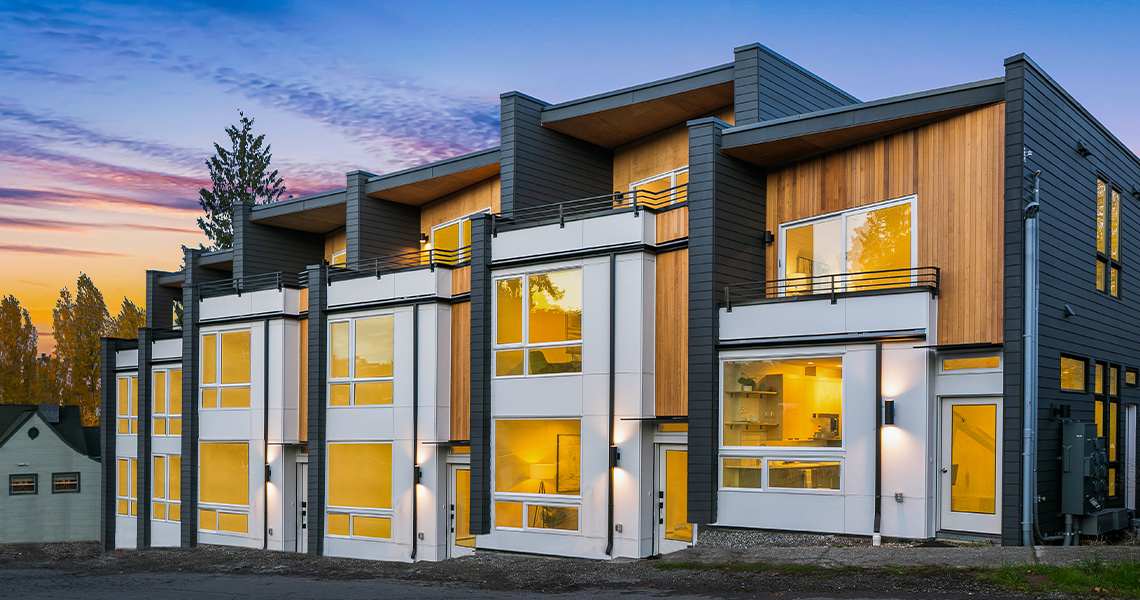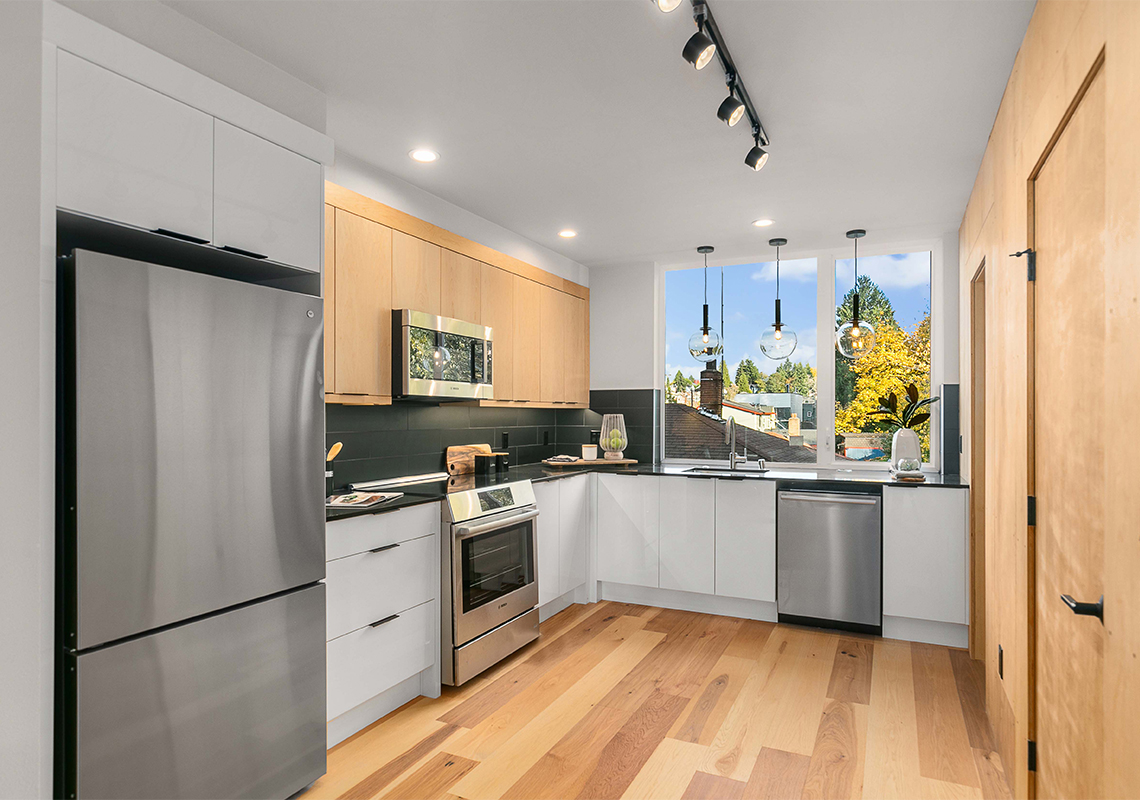By MBAKS Content Strategist James Slone

Reducing greenhouse emissions means housing more people in healthier, more energy-efficient homes in cities near jobs, amenities, and transit. Unfortunately, a lack of affordable options has priced residents out of booming cities like Seattle and into
sprawling suburbs with long, carbonintensive commutes.
A new generation of homebuilders understands that the lack of affordable housing and climate change are related problems requiring interlinked solutions. One of the leading lights in this new way of thinking and acting is Green Canopy NODE.
Where housing is located and who can afford it matters as much as how it’s built—a realization Green Canopy NODE intuitively grasps. For them, solving the housing problem at scale means creating a new paradigm where green housing is accessible
to people of all income levels. It sounds easy, but it’s complicated.
Green at Scale
Green Canopy NODE brought together Seattle-based carbonmitigating construction firm NODE with Green Canopy, a green development and construction company based in Seattle and Portland with a long history helping lead the net zero revolution.
In a 2021 press release announcing their merger, Green Canopy NODE Co-CEO Bec Chapin said that the company’s aim was “an evolution of the industry to build more houses faster that create greater health, wellbeing, and resiliency for people
and communities now and in the future.”
For Aaron Fairchild, Green Canopy NODE co-CEO, it’s as much a moral question as a practical one.
“As humanity continues to grapple with the need to house more people, our communities and planet feel the strain. We’re trying to lessen the strain and offer more regenerative solutions that help build communities while prolonging the life
of the resources required to do so.”
For Green Canopy NODE, transforming the homebuilding industry requires a multifaceted approach: building more housing where it’s needed, offering a full suite of development services to other housing providers, prefabricating building components
offsite, and deploying an impact investment fund for projects.

Build, Build, Build
Green Canopy and NODE’s coming together allowed them to pool their respective experience in green development and technological innovation to scale up construction, leading to their multifaceted approach. I recently chatted with Fairchild to find
out more about each aspect of their overall work.
Obviously, the first is building housing, lots of it.
Green Canopy NODE builds rowhouses, townhomes, and multifamily units because they’re a more affordable option for families who want to live in high-quality neighborhoods with jobs and amenities. They are experts in the “missing middle”
with the real estate chops to secure land for infill development.
Not an easy ask in a city where land value is through the roof.
“It’s hard to build affordable housing in urban areas where housing is needed most,” Fairchild explains. “It requires greater subsidies and a more flexible approach. As time goes on, private, nonprofit, and public partnerships
will become the norm.”
It’s not enough to just build them. They also have to be green.
“Nearly 100 percent of our homes are Built Green or Earth Advantage Certified,” says Fairchild. “At Green Canopy, we historically focused on energy efficiency. We’ve always built all-electric homes and have completed several net
zero homes,” or homes that produce more energy than they take from the grid.
Building green homes not only helps the environment; it also makes housing a more affordable proposition. “Because we build homes that perform well beyond code, utility costs are lower, and residents save money.” Remarkably, the company is
able to deliver net-zero-ready homes to the market at the same price as code-built.
But decarbonization is no longer just about saving energy. Green Canopy NODE has recently started focusing on carbon emitted from the production of their building materials, what’s known as embodied carbon. Making sure embodied carbon doesn’t
outweigh a home’s performance is the next frontier in green building.
Promoting Innovation
Perhaps the most essential element of lowering green construction costs is using new technologies to increase productivity, including standardizing building components, modernizing the workforce by training them in the latest in construction methods,
and manufacturing pre-fab building components.
For Fairchild, manufacturing is especially important. “To scale up and lower costs, the industry will need to embrace the power of off-site manufacturing more and more. It is the only known pathway to the sort of efficiencies required to build more
sustainable, higherquality, lower-cost housing.”
By manufacturing offsite in the controlled environment of a factory and quickly assembling components onsite, Green Canopy NODE avoids inefficiencies. The company is investing heavily in pre-fabricated solutions that can be moved directly from manufacturing
facilities to project sites.
They’re especially excited about fabricating cross-laminated timber (CLT)—an engineered wood product made from wood stacked and glued together at 90-degree angles—for residential mid-to-low rise construction.
CLT is easy to carve and groove with computer-controlled cutting machines, making it uniform and easy to install. The best part? “Along with being a beautiful and exceptionally strong building material,” Fairchild enthuses, “CLT also
sequesters carbon and can be reused at the end of a building’s life."
Spreading the Love: Development Services and Impact Investment
To deliver the high volume of housing needed to have a substantial impact, Green Canopy NODE also needs to be able to employ their strategies on an expansive multi-project scale. The best way to do that is by extending a helping hand to other builders
and nonprofit housing providers.
Their real estate development services have helped complete hundreds of homes reliably and cost-effectively. Current projectpartners include Sunnyside Village Co-Housing, Habitat for Humanity, Africatown Community Land Trust, Homestead Community Land
Trust, and Grow Bainbridge.
Their services cover all aspects of homebuilding, including acquisition, finance, estimating and feasibility, architecture, construction, and warranty services. The key to their services’ effectiveness, says Fairchild, is that they’re vertically
integrated.
“Vertical integration means our team can work with you at any stage of the development process, avoiding the headache of external bottlenecks.” It lowers the cost of developing housing projects because it cuts construction costs by consolidating
different stages like R&D and procurement.
The result is a high degree of flexibility and control. “We’re able to rapidly respond to requests, enhancing our ability to collaborate.” And because the company manages real estate funds, they can drive housing demand in a way that’s
“aligned with our sustainability and technology goals.”
The company created an impact investment fund management firm, Green Canopy NODE Capital, to invest in infill building projects in Seattle and Portland.
Currently, Green Canopy NODE offers both investment and fund management for more than 90 shareholders and over 45 limited partners. Over the last decade, the company has leveraged their building expertise and knowledge of the housing market to raise and
manage over $70 million in accredited investor capital.
Heart and Soul
Green Canopy NODE has already tallied an enviable list of accomplishments. As of this writing, they have built more than 300 Built Green and Earth Advantage Certified homes in and around Seattle and Portland, mitigated 33,000 metric tons of greenhouse
gas, and steered investment to six major infill projects. And they’re just getting started.
This success isn’t just an outcome of their business acumen. It’s driven by a housing philosophy. Housing is the “nexus of our lives,” their website declares, “providing shelter, safety, and security,” a place “where
one can develop a sense of love, belonging, acceptance with friends and family.”
Housing is also a solution to sprawl, homelessness, and climate change. Its importance goes far beyond profitability. It may seem idealistic, but the company genuinely believes that a change in paradigm requires a change in thinking. Fairchild says that
a sense of mission permeates their company culture.
The Green Canopy NODE team, he says, shares a sense of purpose, and “a desire to regenerate communities and environments.” When they take on new team members and partners, they “look for people from communities seeking greater empowerment
and renewal.”
Of course, technology, experience, and expertise are crucial to carrying out the day-to-day work. But it’s their focus on community that may be the key to unlocking the new homebuilding paradigm. It’s the heart and soul of Green Canopy NODE.
Article photos courtesy of Green Canopy NODE